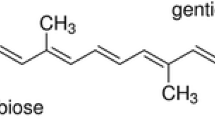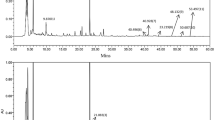Abstract
Diabetic retinopathy (DR) is a serious-threatening complication of diabetes and urgently needed to be treated. Evidence has accumulated indicating that microglia inflammation within the retina plays a critical role in DR. Microglial matrix metalloproteinase 9 (MMP-9) has an important role in the destruction of the integrity of the blood-retinal barrier (BRB) associated with the development of DR. MMP-9 was also considered important for regulating inflammatory responses. Paeoniflorin, a monoterpene glucoside, has a potent immunomodulatory effect on microglia. We hypothesized that paeoniflorin could significantly suppress microglial MMP-9 activation induced by high glucose and further relieve DR. BV2 cells were used to investigate the effects and mechanism of paeoniflorin. The activation of MMP-9 was measured by gelatin zymography. Cell signaling was measured by western blot assay and immunofluorescence assay. High glucose increased the activation of MMP-9 in BV2 cells, which was abolished by HMGB1, TLR4, p38 MAPK, and NF-κB inhibition. Phosphorylation of p38 MAPK induced by high glucose was decreased by TLR4 inhibition in BV2 cells. Paeoniflorin induced suppressor of cytokine signaling 3 (SOCS3) expression and reduced MMP-9 activation in BV2 cells. The effect of paeoniflorin on SOCS3 was abolished by the TLR4 inhibitor. In streptozotocin (STZ)-induced diabetes mice, paeoniflorin induced SOCS3 expression and reduced MMP-9 activation. Paeoniflorin suppressed STZ-induced IBA-1 and IL-1β expression and decreased STZ-induced high blood glucose level. In conclusion, paeoniflorin suppressed high glucose-induced retinal microglia MMP-9 expression and inflammatory response via inhibition of the TLR4/NF-κB pathway through upregulation of SOCS3 in diabetic retinopathy.







Similar content being viewed by others
References
Thomas, R.L., F. Dunstan, S.D. Luzio, S. Roy Chowdury, S.L. Hale, R.V. North, et al. 2012. Incidence of diabetic retinopathy in people with type 2 diabetes mellitus attending the Diabetic Retinopathy Screening Service for Wales: Retrospective analysis. BMJ 344: e874.
Park, Y.G., and Y.J. Roh. 2016. New diagnostic and therapeutic approaches for preventing the progression of diabetic retinopathy. J Diabetes Res. 2016: 1753584.
Cardona, S.M., A.S. Mendiola, Y.C. Yang, S.L. Adkins, V. Torres, and A.E. Cardona. 2015. Disruption of fractalkine signaling leads to microglial activation and neuronal damage in the diabetic retina. ASN Neuro 7: 1759091415608204.
Ibrahim, A.S., A.B. El-Remessy, S. Matragoon, W. Zhang, Y. Patel, S. Khan, et al. 2011. Retinal microglial activation and inflammation induced by amadori-glycated albumin in a rat model of diabetes. Diabetes 60: 1122–1133.
Arnold, T., and C. Betsholtz. 2013. Correction: The importance of microglia in the development of the vasculature in the central nervous system. Vascular cell. 5: 12.
Portillo, J.C., Y.L. Corcino, Y. Miao, J. Tang, N. Sheibani, T.S. Kern, et al. 2016. Cd40 in retinal Muller cells induces P2X7-dependent cytokine expression in macrophages/microglia in diabetic mice and development of early experimental diabetic retinopathy. Diabetes 66: 483–493.
Abcouwer, S.F. 2011. Neural inflammation and the microglial response in diabetic retinopathy. Journal of ocular biology, diseases, and informatics. 4: 25–33.
Nissinen, L., and V.M. Kahari. 1840. Matrix metalloproteinases in inflammation. Biochimica et Biophysica Acta 2014: 2571–2580.
Coussens, L.M., and Z. Werb. 2002. Inflammation and cancer. Nature 420: 860–867.
Rangasamy, S., P.G. McGuire, C. Franco Nitta, F. Monickaraj, S.R. Oruganti, and A. Das. 2014. Chemokine mediated monocyte trafficking into the retina: Role of inflammation in alteration of the blood-retinal barrier in diabetic retinopathy. PloS One 9: e108508.
Kowluru, R.A., Q. Zhong, and J.M. Santos. 2012. Matrix metalloproteinases in diabetic retinopathy: Potential role of MMP-9. Expert Opin Inv Drug. 21: 797–805.
Rodrigues, M., X. Xin, K. Jee, S. Babapoor-Farrokhran, F. Kashiwabuchi, T. Ma, et al. 2013. VEGF secreted by hypoxic Muller cells induces MMP-2 expression and activity in endothelial cells to promote retinal neovascularization in proliferative diabetic retinopathy. Diabetes 62: 3863–3873.
Qin, H., W.I. Yeh, P. De Sarno, A.T. Holdbrooks, Y. Liu, M.T. Muldowney, et al. 2012. Signal transducer and activator of transcription-3/suppressor of cytokine signaling-3 (STAT3/SOCS3) axis in myeloid cells regulates neuroinflammation. Proceedings of the National Academy of Sciences of the United States of America 109: 5004–5009.
Goldmann, T., and M. Prinz. 2013. Role of microglia in CNS autoimmunity. Clinical & Developmental Immunology 2013: 208093.
Yan, C., P.A. Ward, X. Wang, and H. Gao. 2013. Myeloid depletion of SOCS3 enhances LPS-induced acute lung injury through CCAAT/enhancer binding protein delta pathway. FASEB journal : official publication of the Federation of American Societies for Experimental Biology. 27: 2967–2976.
Zhang, W., and S.M. Dai. 2012. Mechanisms involved in the therapeutic effects of Paeonia lactiflora Pallas in rheumatoid arthritis. International Immunopharmacology 14: 27–31.
Zheng, Y.Q., W. Wei, L. Zhu, and J.X. Liu. 2007. Effects and mechanisms of Paeoniflorin, a bioactive glucoside from paeony root, on adjuvant arthritis in rats. Inflammation research : official journal of the European Histamine Research Society 56: 182–188.
Jiang, F., Y. Zhao, J. Wang, S. Wei, Z. Wei, R. Li, et al. 2012. Comparative pharmacokinetic study of paeoniflorin and albiflorin after oral administration of radix paeoniae rubra in normal rats and the acute cholestasis hepatitis rats. Fitoterapia 83: 415–421.
Shi, D., Q. Wang, H. Zheng, D. Li, Y. Shen, H. Fu, et al. 2016. Paeoniflorin suppresses IL-6/Stat3 pathway via upregulation of Socs3 in dendritic cells in response to 1-chloro-2,4-dinitrobenze. International Immunopharmacology 38: 45–53.
Iwahara, N., S. Hisahara, J. Kawamata, A. Matsumura, K. Yokokawa, T. Saito, et al. 2016. Role of suppressor of cytokine signaling 3 (SOCS3) in altering activated microglia phenotype in APPswe/PS1dE9 mice. Journal of Alzheimer's disease : JAD 55 (3): 1235–1247.
Jiang, C., L. Xu, L. Chen, et al. 2014. Selective suppression of microglial activation by paeoniflorin attenuates morphine tolerance. European Journal of Pain 19 (7): 908.
van Beijnum, J.R., W.A. Buurman, and A.W. Griffioen. 2008. Convergence and amplification of toll-like receptor (TLR) and receptor for advanced glycation end products (RAGE) signaling pathways via high mobility group B1 (HMGB1). Angiogenesis 11: 91–99.
Yang, N., H. Cui, F. Han, L. Zhang, T. Huang, Y. Zhou, et al. 2016. Paeoniflorin inhibits human pancreatic cancer cell apoptosis via suppression of MMP-9 and ERK signaling. Oncology Letters 12: 1471–1476.
Rivera, J.C., N. Sitaras, B. Noueihed, D. Hamel, A. Madaan, T. Zhou, et al. 2013. Microglia and interleukin-1beta in ischemic retinopathy elicit microvascular degeneration through neuronal semaphorin-3A. Arteriosclerosis, Thrombosis, and Vascular Biology 33: 1881–1891.
Du, Y., A. Veenstra, K. Palczewski, and T.S. Kern. 2013. Photoreceptor cells are major contributors to diabetes-induced oxidative stress and local inflammation in the retina. Proceedings of the National Academy of Sciences of the United States of America 110: 16586–16591.
Yamagishi, S., N. Nakamura, M. Suematsu, K. Kaseda, and T. Matsui. 2015. Advanced glycation end products: A molecular target for vascular complications in diabetes. Molecular Medicine 21 (Suppl 1): S32–S40.
Bandello, F., R. Lattanzio, I. Zucchiatti, and C. Del Turco. 2013. Pathophysiology and treatment of diabetic retinopathy. Acta Diabetologica 50: 1–20.
Bressler, S.B., M. Melia, A.R. Glassman, T. Almukhtar, L.M. Jampol, M. Shami, et al. 2015. Ranibizumab plus prompt or deferred laser for diabetic macular edema in eyes with vitrectomy before anti-vascular endothelial growth factor therapy. Retina 35: 2516–2528.
Kim, H. 2005. Neuroprotective herbs for stroke therapy in traditional eastern medicine. Neurological Research 27: 287–301.
Gu, X., Z. Cai, M. Cai, K. Liu, D. Liu, Q. Zhang, et al. 2016. Protective effect of paeoniflorin on inflammation and apoptosis in the cerebral cortex of atransgenic mouse model of alzheimer's disease. Molecular Medicine Reports 13: 2247–2252.
Guo, R.B., G.F. Wang, A.P. Zhao, J. Gu, X.L. Sun, and G. Hu. 2012. Paeoniflorin protects against ischemia-induced brain damages in rats via inhibiting MAPKs/NF-kappab-mediated inflammatory responses. PloS One 7: e49701.
Zhang, J., W. Dou, E. Zhang, A. Sun, L. Ding, X. Wei, et al. 2014. Paeoniflorin abrogates DSS-induced colitis via a TLR4-dependent pathway. Am J Physiol-Gastr L. 306: G27–G36.
Liu, H., J. Wang, J. Wang, P. Wang, and Y. Xue. 2015. Paeoniflorin attenuates Abeta1-42-induced inflammation and chemotaxis of microglia in vitro and inhibits NF-kappab- and VEGF/Flt-1 signaling pathways. Brain Research 1618: 149–158.
Jiang, C., L. Xu, L. Chen, Y. Han, J. Tang, Y. Yang, et al. 2015. Selective suppression of microglial activation by paeoniflorin attenuates morphine tolerance. European Journal of Pain 19: 908–919.
Krady, J.K., A. Basu, C.M. Allen, Y. Xu, K.F. LaNoue, T.W. Gardner, et al. 2005. Minocycline reduces proinflammatory cytokine expression, microglial activation, and caspase-3 activation in a rodent model of diabetic retinopathy. Diabetes 54: 1559–1565.
Lee, H.S., J.H. Jun, E.H. Jung, B.A. Koo, and Y.S. Kim. 2014. Epigalloccatechin-3-gallate inhibits ocular neovascularization and vascular permeability in human retinal pigment epithelial and human retinal microvascular endothelial cells via suppression of MMP-9 and VEGF activation. Molecules 19: 12150–12172.
Giebel, S.J., G. Menicucci, P.G. McGuire, and A. Das. 2005. Matrix metalloproteinases in early diabetic retinopathy and their role in alteration of the blood-retinal barrier. Lab invest: a journal of technical methods and pathology 85: 597–607.
Navaratna, D., P.G. McGuire, G. Menicucci, and A. Das. 2007. Proteolytic degradation of ve-cadherin alters the blood-retinal barrier in diabetes. Diabetes 56: 2380–2387.
Bhatt, L.K., and V. Addepalli. 2010. Attenuation of diabetic retinopathy by enhanced inhibition of MMP-2 and MMP-9 using aspirin and minocycline in streptozotocin-diabetic rats. American Journal of Translational Research 2: 181–189.
Lin, M., W.H. Yiu, H.J. Wu, L.Y. Chan, J.C. Leung, W.S. Au, et al. 2012. Toll-like receptor 4 promotes tubular inflammation in diabetic nephropathy. J Am Soc Nephrol: JASN. 23: 86–102.
Chen, X.L., X.D. Zhang, Y.Y. Li, X.M. Chen, D.R. Tang, and R.J. Ran. 2013. Involvement of HMGB1 mediated signalling pathway in diabetic retinopathy: Evidence from type 2 diabetic rats and ARPE-19 cells under diabetic condition. Brit J Ophthalmol. 97: 1598–1603.
Kubo, M., T. Hanada, and A. Yoshimura. 2003. Suppressors of cytokine signaling and immunity. Nature Immunology 4: 1169–1176.
Yoshimura, A., T. Naka, and M. Kubo. 2007. Socs proteins, cytokine signalling and immune regulation. Nature Reviews. Immunology 7: 454–465.
Yan, C., P.A. Ward, X. Wang, and H. Gao. 2013. Myeloid depletion of SOCS3 enhances LPS-induced acute lung injury through CCAAT/enhancer binding protein δ pathway. The FASEB Journal 27: 2967–2976.
Acknowledgments
The authors acknowledge grants from the National Natural Science Foundation of China (Nos. 81173502, 30973534, and 81571069) and the Foundation of Nanjing Medical University (No. 2014NJMUZD015). Clearly state if you received funds for covering the costs to publish in open access.
Author information
Authors and Affiliations
Contributions
Qing-ping Li, Zhi-lan Yuan, Su-hua Zhu and Bing-Qian Liu designed and performed the experiments. Maojuan Hao, Yi-Xin Fan performed the immunoassays. Bingqian Liu, Cheng Qian and Wen-Tao Liu performed the western blotting analysis. Peng Teng, Xiao Wei Zhou and Liang Hu carried out the cell cultures. Zhi-lan Yuan analyzed the results. Qing-ping Li, Su-hua Zhu and Bing-Qian Liu drafted the manuscript. Qing-ping Li secured funding for the project. All authors read and approved the final manuscript.
Corresponding authors
Ethics declarations
Conflicts of Interest
The authors declare that they have no conflicts of interest.
Funding
This work was supported by the National Natural Science Foundation of China (Nos. 81173502, 30973534, and 81571069) and the Foundation of Nanjing Medical University (No. 2014NJMUZD015).
Ethics Approval and Consent to Participate
All procedures were strictly performed in accordance with the regulations of the ethics committee of the International Association for the Study of Pain and the Guide for the Care and Use of Laboratory Animals (The Ministry of Science and Technology of China, 2006). All animal experiments were approved by the Nanjing Medical University Animal Care and Use Committee and were designed to minimize suffering and the number of animals used.
Electronic supplementary material
ESM 1
(DOCX 687 kb)
Rights and permissions
About this article
Cite this article
Zhu, SH., Liu, BQ., Hao, MJ. et al. Paeoniflorin Suppressed High Glucose-Induced Retinal Microglia MMP-9 Expression and Inflammatory Response via Inhibition of TLR4/NF-κB Pathway Through Upregulation of SOCS3 in Diabetic Retinopathy. Inflammation 40, 1475–1486 (2017). https://doi.org/10.1007/s10753-017-0571-z
Published:
Issue Date:
DOI: https://doi.org/10.1007/s10753-017-0571-z




